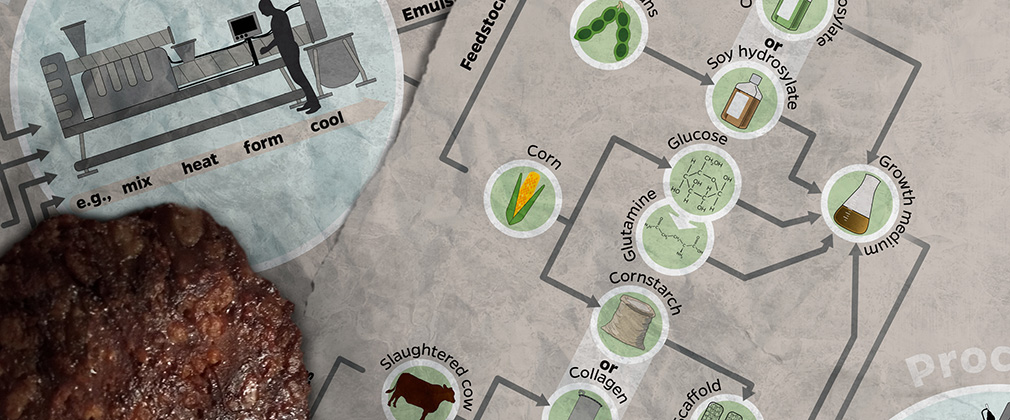Study Offers Public Health and Food Systems Perspective on Meat Alternatives
Aug 31, 2020
The introduction of new plant-based meat and seafood substitutes into popular restaurant menus and the “meat aisle” of grocery stores has generated significant public attention to these products. And while cell-based or “lab-grown” meat and seafood are not yet commercially available, research and development are proceeding rapidly. The surge of interest and investment into these new meat alternatives has been accompanied by heated debate about the potential benefits and risks of their production and consumption.
A new review from the Johns Hopkins Center for a Livable Future (CLF) based within the department of Environmental Health and Engineering at the Johns Hopkins Bloomberg School of Public Health is the first holistic evaluation of meat alternatives using a public health and food systems perspective. It also provides the most comprehensive review to date of the greenhouse gas footprints, land use, and blue (i.e., irrigation) water footprints of plant-based substitutes and cell-based meat.
“Plant-based meat substitutes and cell-based meat products are being marketed to consumers as a way to address issues like climate change, animal welfare, and health concerns associated with farmed meats — without having to compromise on taste,” said Raychel Santo, MSc, lead author of the study and a senior research program coordinator at the CLF. “With this review, we wanted to evaluate the state of the evidence on the purported benefits of these products, highlight the complexity of the issues at hand, and identify areas where more research is needed.”
To conduct the analysis, researchers reviewed and cited more than 80 articles on the public health, environmental, animal welfare, economic, and policy implications of meat alternatives, and assessed how they compared to farmed meat. The researchers note that since cell-based meat has not yet been commercialized, existing research about its impacts is limited and largely speculative. They also caution that much of the existing research on plant-based substitutes and cell-based meats has been funded or commissioned by companies or organizations that are developing or promoting these products. They emphasize that these factors speak to an urgent need for more independently-funded, peer-reviewed studies to further inform the conversation around the development and commercialization of plant-based substitutes and cell-based meats.
Based on the evidence available to date, the review found that plant-based meat substitutes have substantially smaller carbon, land, and blue water footprints and require fewer pesticides to produce compared to conventionally-farmed beef. Compared to farmed pork, poultry, eggs, and some types of seafood, the environmental benefits of plant-based substitutes were generally less pronounced. In the case of cell-based meat, the potential environmental footprints were generally lower than those of farmed beef and comparable to or worse than those of other farmed meats and seafood, although further research is needed.
The review also found that there has been limited research on nutrition, chronic disease, and food safety implications associated with consuming meat alternatives, and occupational and community health implications associated with their production. For example, it is unknown whether replacing farmed meat with plant-based substitutes would offer similar nutritional and health benefits as compared to less-processed plant foods. Potential health impacts associated with cell-based meat are unclear at this time, as there is a high degree of uncertainty around the nutritional value of these products, the scope and nature of antibiotic use in cell-based meat production, and waste management practices that will be adopted by the industry.
From an animal-welfare perspective, if meat alternatives replace even a small share of farmed meat production, it could substantially reduce the number of animals raised and killed for human consumption. Cell-based meat will, however, require further technological developments to remove all animal-based inputs.
The researchers also note that the broader socioeconomic and political implications of a widescale replacement of farmed meat with meat alternatives are frequently omitted from existing research and demands further attention. For example, the production and consumption of meat alternatives do not inherently address concerns associated with food industry consolidation, the livelihoods of farmers and other food system workers, inequitable supply chains, the affordability of healthy diets, and the racial injustice perpetuated by the current systems.
“While meat alternatives may offer benefits over some farmed meats, these products aren’t a silver bullet for addressing many urgent issues associated with our current industrialized model of animal agriculture,” said Keeve Nachman, PhD, senior author of the study and director of the CLF’s Food Production and Public Health Program and an associate professor with the Bloomberg School’s Department of Environmental Health and Engineering. “It is critical to remain cautious and nuanced in discussing their merits rather than assuming that they will solve these challenges without any drawbacks.”
“It's also important to note that we are not limited to a choice between conventional meat and meat alternatives,” adds Santo. “There are many other healthy, environmentally sustainable, and ethical proteins to choose from, including whole plant proteins like dried beans and lentils, and more sustainably produced animal products.”
“Considering plant-based meat substitutes and cell-based meats: A public health and food systems perspective,” was written by Raychel E. Santo, Brent F. Kim, Sarah E. Goldman, Jan Dutkiewicz, Erin M.B. Biehl, Martin W. Bloem, Roni A. Neff, and Keeve E. Nachman, and published in the journal Frontiers in Sustainable Food Systems.
Illustration by Mike Milli
